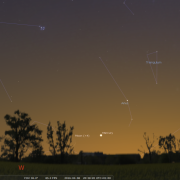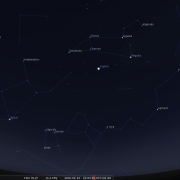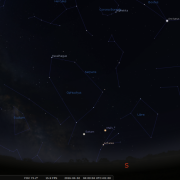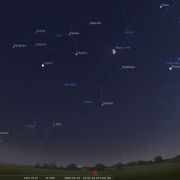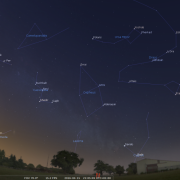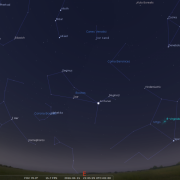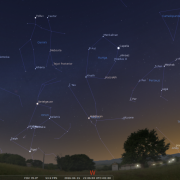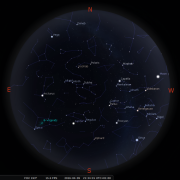In this month's Sky Notes:
Planetary Skylights

 Although Jupiter is currently the brightest planet in the sky, April is all about Mercury, which has its best apparition of the year. Closest to the Sun, Mercury never strays far from the general direction of our nearest star, and hence is only seen in a twilight sky, before sunrise or shortly after sunset. Even for a good apparition Mercury barely reaches 10-12 degrees above the horizon, before arcing back down, a period lasting no more than 4 weeks. Not surprisingly Mercury is the most elusive of the visible naked eye planets to spot.
Although Jupiter is currently the brightest planet in the sky, April is all about Mercury, which has its best apparition of the year. Closest to the Sun, Mercury never strays far from the general direction of our nearest star, and hence is only seen in a twilight sky, before sunrise or shortly after sunset. Even for a good apparition Mercury barely reaches 10-12 degrees above the horizon, before arcing back down, a period lasting no more than 4 weeks. Not surprisingly Mercury is the most elusive of the visible naked eye planets to spot.
In order to see Mercury this coming month you will require a clear West-to-WNW horizon. Wait until 40 minutes after sunset before scanning above the horizon. Use binoculars initially, Mercury will be the brightest ‘star’ in this direction. Once located, you should then be able to spot it with just the naked eye, appearing surprisingly bright in the twilight sky. Mercury reaches greatest eastern elongation on the 18th when it will be 10 degrees above the horizon, however it will be brightest earlier in the month, so the optimum dates to view will be from 8th-12th. A very slim crescent moon lies to the left of Mercury on the 8th.
Conspicuous Jupiter dominates the evening sky residing below the stars of Leo over in the south as twilight deepens. As it is the brightest object it cannot be mistaken. For the majority of observers Jupiter is now at its most convenient to scrutinize through a telescope. It is always a rewarding spectacle. Note the current state of the banding across its disk, and the size and hue of the great red spot – when visible. The nightly dance of the attendant Galilean moons, is also always of great fascination. Jupiter resides above our moon on the 17th.

 Mars and Saturn are still morning objects, although they are now rising earlier post midnight. Mars has an obvious ‘orange’ hue and is gradually brightening as it heads toward a May opposition date. Telescopically, the disk still appears disappointingly small (nowhere near the size of Jupiter’s, even when Mars is at its very best) but a 6 inch scope or larger may reveal some general surface markings. Saturn resides to the left of Mars and appears pearly white to the naked eye. Turn a scope toward Saturn and you will be greeted by one of nature’s most beautiful sights – the glorious ring system. The moon passes Mars and Saturn on the 25th-26th.
Mars and Saturn are still morning objects, although they are now rising earlier post midnight. Mars has an obvious ‘orange’ hue and is gradually brightening as it heads toward a May opposition date. Telescopically, the disk still appears disappointingly small (nowhere near the size of Jupiter’s, even when Mars is at its very best) but a 6 inch scope or larger may reveal some general surface markings. Saturn resides to the left of Mars and appears pearly white to the naked eye. Turn a scope toward Saturn and you will be greeted by one of nature’s most beautiful sights – the glorious ring system. The moon passes Mars and Saturn on the 25th-26th.
For a more in-depth look at April’s planetary movements, please refer to your 2016 Night Scenes, assuming you have a copy.
Meteor Showers

A number of lesser meteor showers occur during April. The Virginids and Alpha Scorpiids each have zenith hourly rates (ZHR) of around half a dozen, equating to ‘normal’ sporadic meteor activity levels. The Virginids peak on April 7/8th, which is a ‘no moon’ window, therefore increased sightings of Virginids during the early morning hours is quite likely. The Scorpiids peak on the 27th and will be hampered a little by a waning moon in the early morning hours.
The month's most prolific shower, the Lyrids, peak over the 22/23rd. Normally having a ZHR of around 20 per hour, a full moon on the 21st will severely restrict observations this year.
March 2016 Sky Charts
Click each image to see a full-size Sky Chart:
|
Looking South
Mid April - 21:00h |
Looking North |
|
Looking East
Mid April - 21:00h |
Looking West
Mid April - 21:00h |
|
|
|
|
Overview
9th April - 21:35h |
|
Additional Image Credits:
- Planets and Comets where not otherwise mentioned: NASA
- Sky Charts: Stellarium Software
- Log in to post comments

